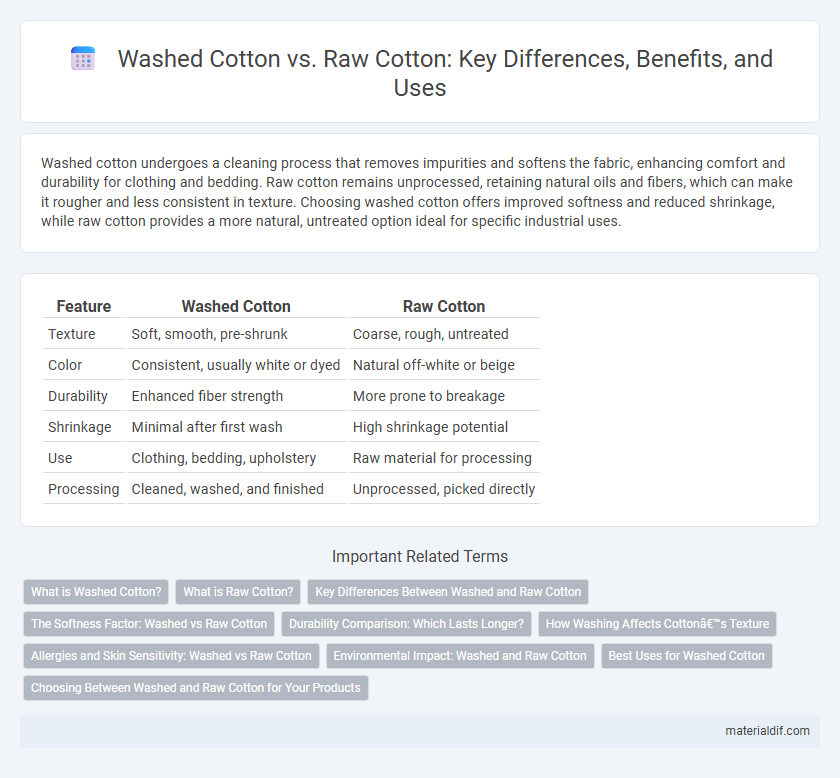Washed cotton undergoes a cleaning process that removes impurities and softens the fabric, enhancing comfort and durability for clothing and bedding. Raw cotton remains unprocessed, retaining natural oils and fibers, which can make it rougher and less consistent in texture. Choosing washed cotton offers improved softness and reduced shrinkage, while raw cotton provides a more natural, untreated option ideal for specific industrial uses.
Table of Comparison
| Feature | Washed Cotton | Raw Cotton |
|---|---|---|
| Texture | Soft, smooth, pre-shrunk | Coarse, rough, untreated |
| Color | Consistent, usually white or dyed | Natural off-white or beige |
| Durability | Enhanced fiber strength | More prone to breakage |
| Shrinkage | Minimal after first wash | High shrinkage potential |
| Use | Clothing, bedding, upholstery | Raw material for processing |
| Processing | Cleaned, washed, and finished | Unprocessed, picked directly |
What is Washed Cotton?
Washed cotton refers to raw cotton that has undergone a washing process to remove impurities such as natural oils, dirt, and debris, enhancing its softness and breathability. This treatment improves the fabric's texture, making it more comfortable and less prone to shrinkage after washing. Washed cotton is favored in clothing production for its smooth feel and durability compared to untreated raw cotton.
What is Raw Cotton?
Raw cotton refers to the natural fiber harvested directly from the cotton plant, containing seeds, dirt, and plant debris before any cleaning or processing. This unprocessed state retains impurities and natural oils, requiring ginning and refining steps to produce clean, usable cotton fibers. Raw cotton serves as the essential starting material for textile manufacturing and further treatments like washing and bleaching.
Key Differences Between Washed and Raw Cotton
Washed cotton undergoes a cleaning process that removes natural impurities, resulting in a softer texture and enhanced breathability compared to raw cotton, which retains its natural oils and stiffness. The washing process also imparts a faded, vintage look to washed cotton, whereas raw cotton has a crisp, fresh appearance with a slightly rough feel. Durability and shrinkage vary, with washed cotton often being pre-shrunk and more flexible, while raw cotton tends to shrink more and feels stiffer until softened through laundering.
The Softness Factor: Washed vs Raw Cotton
Washed cotton undergoes a washing process that removes impurities and softens the fibers, resulting in a noticeably smoother and more comfortable texture compared to raw cotton. Raw cotton retains its natural stiffness and roughness due to the presence of natural waxes and residues, making it less soft and less suitable for immediate textile use. The softness factor in washed cotton enhances breathability and wearability, contributing to a gentler feel against the skin.
Durability Comparison: Which Lasts Longer?
Washed cotton undergoes a cleaning and softening process that slightly weakens its fiber strength compared to raw cotton, which retains its natural tensile properties. Raw cotton fibers are generally more durable and resistant to wear, making garments crafted from raw cotton last longer under heavy use. However, washed cotton offers better comfort and shrink resistance, trading some durability for a softer feel.
How Washing Affects Cotton’s Texture
Washing cotton significantly softens its texture by breaking down the fibers' stiffness and removing natural impurities, resulting in a smoother, more breathable fabric. Raw cotton retains a coarse and rigid texture due to its unprocessed fibers and residual plant oils, which can cause irritation when worn. The washing process enhances cotton's comfort and durability by improving its absorbency and flexibility, making washed cotton ideal for clothing and home textiles.
Allergies and Skin Sensitivity: Washed vs Raw Cotton
Washed cotton undergoes a cleaning process that removes natural oils and impurities, reducing allergens and irritants, making it a better choice for sensitive skin and allergy sufferers. Raw cotton retains its natural residues such as dust, pollen, and lanolin, which can trigger allergic reactions and cause skin irritation. Choosing washed cotton textiles can significantly minimize the risk of eczema, dermatitis, and other skin sensitivities associated with fiber exposure.
Environmental Impact: Washed and Raw Cotton
Washed cotton undergoes extensive water and chemical use during processing, leading to higher environmental pollution and increased carbon footprint compared to raw cotton. Raw cotton, being unprocessed, retains its natural state, minimizing water consumption and reducing chemical runoff, which makes it a more sustainable choice for eco-conscious consumers. Choosing raw cotton can significantly decrease environmental degradation associated with cotton production and textile manufacturing.
Best Uses for Washed Cotton
Washed cotton offers a softer texture and reduced shrinkage, making it ideal for comfortable apparel like casual shirts, bedding, and children's clothing. Its pre-washed treatment enhances breathability and durability, suitable for everyday wear and home textiles. Compared to raw cotton, washed cotton requires less maintenance and provides a smoother finish for products prioritizing comfort and softness.
Choosing Between Washed and Raw Cotton for Your Products
Washed cotton offers softness and reduced shrinkage, making it ideal for comfortable apparel and eco-friendly products that require minimal chemical treatment. Raw cotton retains natural fibers and strength, providing durability and versatility suitable for industrial textiles and products needing further customization. Selecting between washed and raw cotton depends on the end-use, with washed cotton preferred for softness and raw cotton for strength and adaptability.
Washed Cotton vs Raw Cotton Infographic

 materialdif.com
materialdif.com